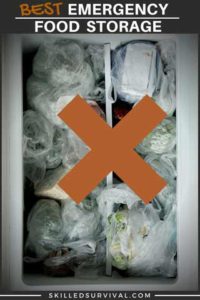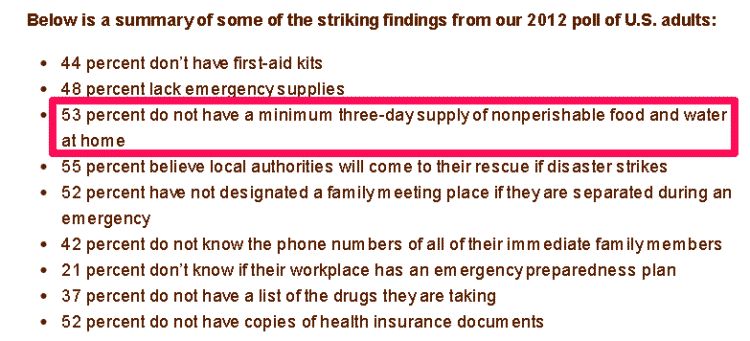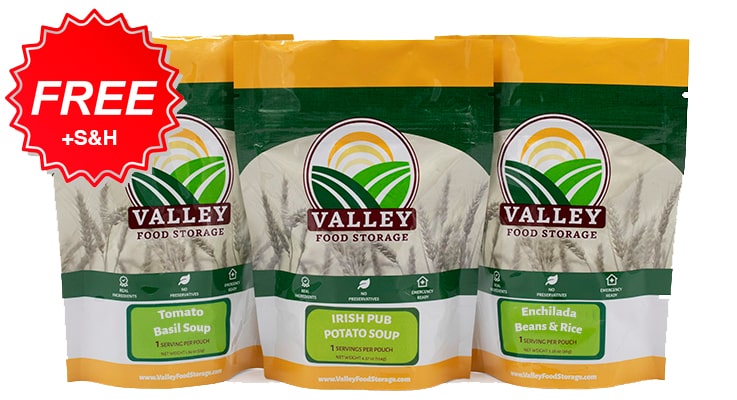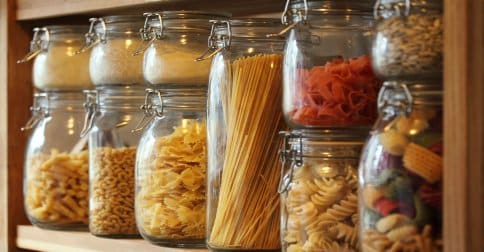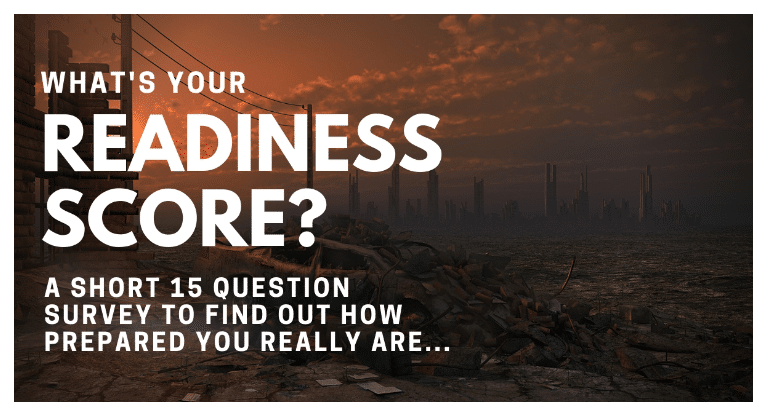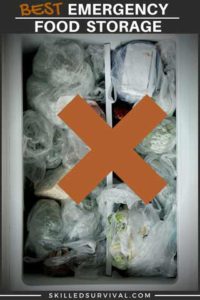
Emergency food storage is easy.
Just buy a bunch of random foods from the grocery store and put them in your pantry, right?
Not so fast…
That’s a recipe for disaster and you’ll likely end up wasting the money you spend on all that food.
That’s why today we will cover the following emergency food stockpile topics:
- Why You Should Never Rely Soley On Your Freezer
- Basic Emergency Food Storage Principles
- Best Ways To Start
- “Do It Yourself”, “Done For You” Or Both?
- Saving Money On Emergency Foods
- What You Should Buy
- Maintaining Your Food Supply
- Using Food As A Bargaining Tool
Are You Ready For The Tough Times Ahead? Take My 60 Sec Quiz To See If You’re Part Of ‘The Fragile Masses’ Or Not… Start Quiz Now!
Why You Should Never Rely Soley On Your Freezer
Right now, I’ve got an extra-large chest freezer in my basement.
It stores heaps and heaps of delicious and nutritious foods that are all patiently waiting for their turn at my dinner table; just thaw, cook, and devour.
Large chest freezers are a modern convenience that you should absolutely consider for you and your family.
You can store extra meats, cheeses, bread, and desserts when you find them on clearance. You can be ready for large family visits and holiday dinners.
There are plenty of reasons for owning and utilizing a large freezer, but survival food storage isn’t one of them.
I cannot think of a single catastrophic event where you’re guaranteed a reliable supply of grid power:
- Natural disasters? No
- Civil Unrest and Riots? Nope
- Terrorist Nuclear Attacks? Nada
- EMP Attack? No way
That’s why it is so important for your emergency food storage to be grid-INdependent. Freezers are grid-dependent appliances.
When The Grid Goes Down Your Freezer Stops Freezing.
Now maybe you get lucky, and your freezer is in your garage or barn and it’s below 32 degrees outside for the foreseeable future.
Or you might have an emergency solar generator and can turn it on and off strategically throughout the day and keep your frozen goods thawing for weeks.
But what if you’re unlucky, and grid power goes out in the middle of a heatwave?
Regardless of any of these scenarios, your freezer chest is tied to the word LUCK.
Luck should never be a part of your vocabulary.
In a long-term survival scenario with no grid power, you’re going to lose most of your frozen foods.
Sure you can probably salvage some of it…
Bread will last for a few weeks, and cheeses won’t go bad overnight but the meats…you will lose a lot of your meats within days.
You should cook and eat as much of the meats as you can, but it’s going to be a losing battle.
Plus, the problem of indecision comes into play.
Will the grid power come back on within a few days? Then it’s best to leave the freezer closed and keep as much cold air from escaping as possible.
Will it be a longer-term weeks/months type of power grid failure situation? Then you should start cooking and eating as much of the meat as possible right away.
Soon, you’ll have a problem with what to do with all the rotten meat. It’s going to get rancid and inadequate disposal methods will attract unwanted attention (neighbors, rodents, and wild animals).
So by now, I hope you get my point…a large stocked freezer is NOT a reliable emergency food storage tool.
What about your local grocery store for survival food? You cannot rely on the grocery store for your emergency food stockpile because, in a real emergency, it will empty in hours and will not be restocked anytime soon.
You could have all the money in the world; with nothing to buy.
So you should focus on high-quality packaged freeze-dried meals, long-shelf life foods, and food pantry stock rotation (I do both).
Just because you don’t have any survival food yet, doesn’t mean it’s too late to start.
You can start today, and you’ll be better off for it.
If you are like most fellow Americans the amount of food you have in your pantry right now might last a few days…at best.
The Surprising Reason People Live A Fragile Life
Basic Survival Food Storage Principles
So you want to start building your emergency food storage but don’t know where to start? There are a few core principles to keep in mind:
- Food should be non-perishable. Foods such as freeze-dried meals, canned goods, dried foods in bulk, or dried meat products like pemmican. These food materials can last for the long term, up to decades if sealed properly, which means you will have food for even the worst-case scenarios.
- Consider buying processed food. No, it’s not as healthy, but it does last longer than organic food. Plus starvation is even worse for your health than processed foods. So you can worry about restoring your health once the crisis ends; until then, focus on surviving day by day.
- Store your food supplies somewhere cool and dry. A dry basement is ideal and can work provided you keep the emergency food storage dry, cool, and away from the vermin and the elements.
- Figure out how many calories each family member needs per day. Then calculate how much food you need to meet your survival food goals.
As A Way To Introduce You To Skilled Survival, We’re Giving Away Our Family First Food Planning Guide. Click Here To Get Your FREE Copy Of It.
Another principle to consider is to include some variety and don’t forget about convenience.
If you’re in a survival situation, variety will be more important than you think.
Morale will already be low, and kids or grandkids will likely be scared and unsure of what to do. When the future looks bleak, it doesn’t help to compound the issue by eating the same thing day in and day out.
Including a variety of tastes and textures with your emergency food supplies can help keep spirits up, something that is of vital importance in a disaster situation.
Convenience is important, too, particularly immediately following the disaster when everyone is still adjusting to the new lifestyle. If you have food that you can eat directly out of its packaging without cooking it, be sure to utilize that.
Canned tuna is good for this. Just open the package, and eat. There’s preparation or cooking involved.
How To Start Building Your Stockpile
The next hurdle you need to overcome is building up your emergency food stockpile.
If you live in a smaller home or an apartment, it can be challenging to find places to store your food. The first step is to search out unique food storage ideas.
Do you have an unused cabinet space where you can place food? What about a closet in a guest room somewhere that goes virtually untouched?
Another alternative is to find places that are used only for storage and clean them out. Get rid of items you don’t need.
Once you’ve done that, there will be plenty of places for you to put extra food and supplies.
Building up a massive amount of survival food is about planning, coordination, and preparation. You can start slowly, start you must.
There’s no need to exhaust yourself with the rush. Sit down and calculate your family’s minimum nutritional needs.
- What is your daily calorie intake?
- What do you need to survive?
- Are there any special dietary requirements for anyone in your family?
All of these questions are important, so take notes.
Create a document with all of this information (a physical copy, not a digital one) and keep it hidden with your supplies. Understand exactly what each person needs to consume each day to survive.
If there are special dietary needs, make sure to meet those needs when you begin building up your emergency food storage. It may be more difficult, but they’re family so it’s worth it.
As A Way To Introduce You To Skilled Survival, We’re Giving Away Our Family First Food Planning Guide. Click Here To Get Your FREE Copy Of It.
“Do It Yourself”, “Done For You” or Both?
If you want to build your emergency stock yourself, then take time in that first week to build up a three-day supply. This will last you through most minor problems like a power outage from a storm or a blimp with the power company.
Once you have a three-day supply, focus on building up a one-month supply. A one-month supply will be sufficient for 99% of situations, ranging from mass evacuations because of a natural disaster to localized attacks on the power grid.
Then, over the next several months, focus on building up a one-year supply.
If you prefer a faster simpler method, you can purchase bulk specialty sealed foods from a survival food storage.
I personally use Valley Food Storage. They have lots of options at different price points to choose from.
With Valley Food Storage you’ll:
- Get ready sooner
- Have peace of mind sooner
- Get very high-quality packaging and storage buckets
- Get delicious and a good variety of food
I recommend you do a bit of both DIY and Done For You.
Buy SOME Valley Food Storage today. That way, if something happens next week, you’ll be in good shape. Once you’ve got an initial order of survival food, you’ll continue to build on that each month.
Click here to claim your FREE 3-pack of survival food from Valley Food Storage (+S&H).
This 3-pack sells for $60.00 on Valley Food Storage’s website. So getting it for only S&H is a steal of a deal.
Click here to claim your FREE 3-pack of survival food (+S&H) while supplies last.
Here is a review and taste test of some Valley Food Storage freeze-dried meals that I published on our YouTube channel.
Valley Food Storage Review & Unboxing
Here’s another video of me purchasing from Valley Food Storage to top off my survival food supplies.
Valley Food Storage Purchase
Plus, you can take a deep breath and take a little bit of time to build up your grocery stock rotation too.
I recommend targeting a minimum of a one-year emergency food storage, which will be necessary for a total disaster. Your emergency food storage could also become your survival (and bargaining) tool in the event of an economic collapse.
If the country ever went to war on its own soil, the one-year survival food kit is your family’s lifeline. That is what you will use to eat each day, as well as to bargain with others who need food.
More on bargaining later…
As A Way To Introduce You To Skilled Survival, We’re Giving Away Our Family First Food Planning Guide. Click Here To Get Your FREE Copy Of It.
Saving Money on Survival Food
If costs are a big concern, then you need to figure out ways to do this on a budget over time.
Food costs are rising every day. It’s expensive to eat normally, much less build an emergency food stockpile. That’s why it is important to shop carefully.
And while food inflation seems to be under control, hidden food inflation is NOT. So it’s going to be a bit of an uphill battle.
But try buying just a few extra cans of fruit or dried meat each time you go to the supermarket. Over time, that will build into quite a sizable emergency food supply.
Take a page from the ‘couponing’ playbook and look for coupons online, in the daily paper, and in stores. The “Extreme Couponers” save hundreds or even thousands of dollars at the grocery store by buying in bulk.
If you want to take the time to plan out a trip to a supermarket, it can certainly be beneficial to do so.
Pay attention to when stores have special sales, or when double coupons are advertised. Shop on those days. If you plan carefully, you can save a lot of money that might otherwise be wasted.
Dollar stores and pharmacies also sell food at discounted prices. Check those locations for additional savings.
Or go the ultimate DIY route and get a good food dehydrator. Which allows you to dehydrate fruits and meats.
Learn how to make your own long-term survival foods such as pemmican and hardtack.
Building your emergency food storage doesn’t need to empty your bank account, it can be accomplished in such a way that it won’t break the bank.
What Kinds Of Survival Food Should You Buy?
We’ve covered the basics on how to buy, where to put it, and how to do it on a budget.
But the question remains: what kind of food SHOULD you buy?
Take the time to monitor your family for a week and notice what foods they normally consume.
To return to the issue of morale mentioned earlier, keeping things as normal as possible is good for everyone. If you can find non-perishables that are similar to the day-to-day diet of everyone in your home, it will make the transition easier.
In addition, make sure to get these longer-term emergency staples.
These are the staple foods of cultures all over the world and will keep you alive for a long time, even if the diet is rather bland.
Ensuring you have these basic supplies will make it easier to reach the dietary macros your body requires.
A few other items to include are peanut butter, trail mix, saltine crackers, and mixed nuts.
The salt in the nuts and the crackers will preserve them for years, even if they do become stale after a while.
The peanut butter and trail mix are great ways to get some additional protein because the meat will be in short supply unless you hunt it yourself.
Maintaining Your Emergency Food Storage
Rotate your stored survival food on a regular basis.
Try to avoid any of it going past its expiration date but don’t just throw it out if it does, oftentimes canned food is still good long after its labeled expiration date. However, you can use the “first in, first out” stock rotation method to manage this.
Here’s a video showing a fantastic way to manage “first in, first out” emergency food storage rotation.
FIFO Can Rack
Getting a can storage rack will definitely prevent you from wasting your stockpiled food. It helps to prevent you from forgetting about those old cans in the back of your food stockpile.
Remember, this supply isn’t meant to last forever – just long enough to make it through the crisis.
No food will last forever, so make sure you keep your emergency food storage up to date with at least a year’s lifespan.
There are additional advanced techniques you can employ to keep food for years and years but the best place to start is to figure out your family’s calorie food needs.
As A Way To Introduce You To Skilled Survival, We’re Giving Away Our Family First Food Planning Guide. Click Here To Get Your FREE Copy Of It.
Using Food As A Bargaining Tool
As mentioned briefly earlier in the post, bargaining is a major component of a disaster.
When a large-scale disaster happens, several things are bound to occur. People with nothing to lose will turn to stealing and violence to get what they need, and everyone will fend for themselves. When society is gone, money won’t matter; survival and food will.
If you have proper food stores, you have a bargaining tool.
You can trade food in exchange for safety or even information.
It may be the only tool at your disposal in keeping your family safe, and it is important you do so. When you come across other people, you can trade some of your food for supplies you may not have.
Not only will it prevent you from going hungry that night, but a proper survival food stockpile will be the only recognized currency of value in the event of a disaster.
Final Thoughts
Keeping proper food supplies is just the first step in ensuring your family’s safety and survival. When disaster strikes, everyone will be looking out for themselves and you can not rely on the government.
It is up to you and you alone to ensure that your family comes out on the other side of a disaster safe and sound.
And avoid becoming just another statistic to be lamented by the survivors.
Having an emergency food plan is vitally important. Storing clean water, and nonperishable food, and knowing basic survival skills will keep help make you one of the few survivors.
Prepare, Adapt, and Overcome,
“Just In Case” Jack
P.s. Are you ready for the tough times ahead?
Find out now by taking my short Readiness Score Quiz – it’s absolutely free.
Once complete, you’ll know exactly where you stand on the “fragile” vs.” resilient” spectrum.
So click here to start the Quiz….And don’t worry; the questions are so easy a 3rd grader could answer them.
Click on the image to begin the Quiz and find out once and for all if you’re part of “The Fragile Masses” or “The Resilient Few.”
Top Image Source
The post Emergency Food Storage For Long Term Power Outages appeared first on Skilled Survival.


